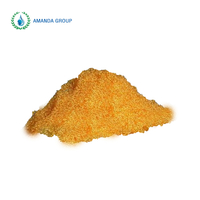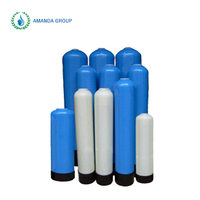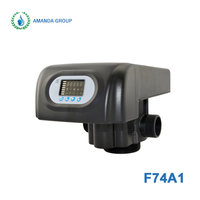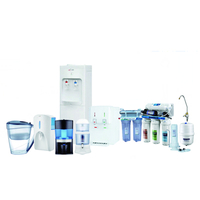What is soft water?
Softened water is water in which the hardness (mainly calcium and magnesium ions in water) is removed or reduced to a certain extent. In the process of softening water, only the hardness is reduced, while the total salt content remains unchanged.

The difference between soft water and other water?
Raw water, is the water that has not been treated. In a broad sense, for the water before entering the water treatment process is also called raw water.
Desalinated water, refers to the water salts (mainly strong electrolytes dissolved in water) removed or reduced to a certain degree of water.
Pure water, refers to the strong electrolytes and weak electrolytes (such as SiO2, CO2, etc.) in the water, remove or reduce to a certain extent. The salt content is <1mg/L.
Ultra-pure water, is water in which the conductive medium is almost completely removed, while the non-dissociated gases, colloids and organic substances (including bacteria, etc.) are also removed to a very low degree.
What is water softening?
Use the ion exchange resin to replace the calcium and magnesium ions in the raw water, and then the boiler feed water filtered out by the water softening equipment is the boiler with very low hardness softened clean water.

What is the best way to soften hard water?
Ion-exchange method:
Method: The ion exchange resin is used to replace the calcium and magnesium ions in the water with sodium ions. Since the solubility of sodium salts is high, it avoids the generation of scale with the increase of temperature.
Features and effects: The effect is stable and accurate, and the process is mature. It can reduce the hardness to 0.
Scope of use: in applications such as catering, food, chemical, pharmaceutical, air conditioning, industrial circulating water, etc. The most commonly used standard way at present.

Electromagnetic method:
Method: Using a certain electric or magnetic field in the water to change the characteristics of the ions, thus changing the rate of calcium carbonate (magnesium carbonate) deposition and the physical characteristics of the deposition to stop the formation of hard water scale.
Features effect: small investment in equipment, easy to install, low operating costs. The effect is not stable enough and has some limitations.
Scope of application: mostly used in commercial (such as central air conditioning, etc.) circulating cooling water treatment, can not be applied to industrial production and boiler make-up water treatment.
Membrane Filtration Method:
Method: Both nanofiltration membrane (NF) and reverse osmosis membrane (RO) can intercept calcium and magnesium ions in water, thus fundamentally reducing the hardness of water.
Feature Effect: The effect is obvious and stable, and the treated water is applicable to a wide range. There are high requirements for inlet water pressure, and the equipment investment and operation cost are higher.
Scope of application: Generally less used for special softening treatment.

Lime method:
Method: Add lime to the water.
Characteristic effect: It can only reduce the hardness to a certain range.
Scope of application: Suitable for high hardness water with high flow rate in the range.
Dosing method:
Method: Add special scale inhibitor to water, which can change the characteristics of calcium and magnesium ions combined with carbonate ions, so that scale cannot precipitate and deposit.
Characteristic effect:Less one-time investment and wide adaptability.
Scope of application:Because of the addition of chemical substances, the application of water is greatly restricted, and generally cannot be applied to drinking, food processing, industrial production, etc.
How do water softening systems work?
There are five processes: working (sometimes called produced water), backwash, brine (regeneration), slow rinse (replacement), and fast rinse. All processes are very close from one water softening plant to another, except that there may be some additional processes due to differences in the actual process or the need for control. Any water softening equipment based on sodium ion exchange is developed on the basis of these five processes.
Backwash: After working for a period of time, the equipment will intercept a lot of dirt brought by the raw water in the upper part of the resin, after removing these dirt, the ion exchange resin can be fully exposed and the regeneration effect can be guaranteed. The backwash process is that the water is washed in from the bottom of the resin and out from the top, so that the dirt intercepted at the top can be washed away. This process generally takes about 5-15 minutes.

Brine (regeneration): is the process of injecting brine into the resin tank, traditional equipment is to use salt pumps to inject brine, fully automatic equipment is to use a special built-in injector to inhale the brine (as long as the incoming water has a certain pressure). In the actual working process, the regeneration effect of brine flowing through the resin at a slower speed is better than simply soaking the resin with brine, so the water softening equipment is regenerated by the method of slow flow of brine through the resin, the process generally takes about 30 minutes, the actual time is affected by the amount of salt used.
Slow rinse (replacement): After the brine flows through the resin, the process of slowly rinsing all the salt in the resin with the same flow rate is called slow rinse, because there are still a large number of calcium and magnesium ions on the functional groups in this rinse process by the sodium ion exchange, according to practical experience, this process is the main process of regeneration, so many people call this process replacement. This process usually takes the same time as the salt absorption, about 30 minutes.
Fast rinse: In order to rinse the residual salt thoroughly, the resin should be rinsed with raw water at a flow rate close to the actual work, and the final effluent of this process should be soft water up to standard. In general, the fast rinse process is 5-15 minutes.
Application of soft water treatment equipment:
① Heating
② Cooling water
③ Process water
④ Steam boiler
⑤ Iron and steel smelting
⑥ Chemical and pharmaceutical
Water softening equipment selection:
①Control Valve: divided into automatic control and manual control.

② Resin tank: softening water device tank material is divided into glass steel, stainless steel.
③ equipment control form: one is the preparation of water to reach the set value is automatically restored, known as flow type; for all water supply system softening water treatment equipment. The second is to time for the control of regeneration measurement, known as the time type; applicable to water supply systems with stable water volume, the shortest reduction regeneration cycle of 24 hours.
④ Equipment combinations.
Single-controlled single-bed: stop water supply for 2 hours or continue to supply raw water during the reduction (hard water bypass).
Single-controlled double bed: alternate water supply, one with one backup type.
Double-controlled double bed: alternate water supply, one use and one standby type.
Double control double bed: simultaneous water supply, alternate regeneration.
Multi-controlled several beds: more than three water softening resin tanks are used in parallel, suitable for large water supply systems.
It can be widely used for softening the make-up water of steam boilers, hot water boilers, exchangers, evaporative condensers, air conditioners, direct combustion engines and other systems. It can also be used for the treatment of domestic water in hotels, restaurants, office buildings, apartments, homes and other industries such as food, beverage, brewing, laundry, printing and dyeing, chemical and pharmaceutical softening water treatment.
Water treatment accessories:
Filter media, filter cartridge, booster pump, reverse osmosis membrane, membrane housing, precision filter, flow meter, pressure gauge, ozone generator, ultraviolet sterilizer, scale inhibitor, water distributor, etc.










